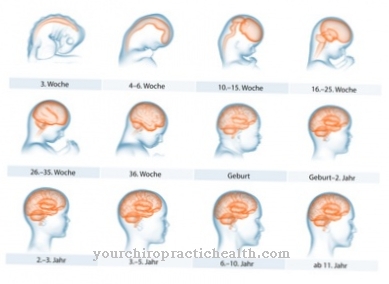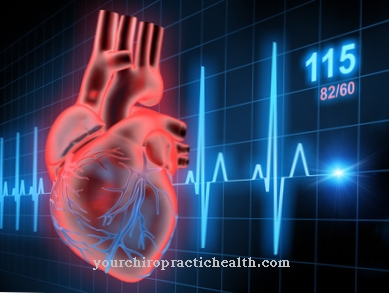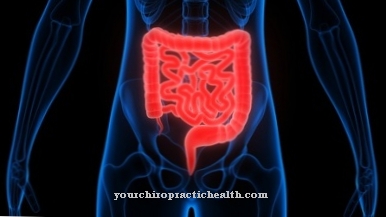As Introception all perceptions from within the own body are summarized. The introception regulates one's own well-being and encompasses not only the proprioception of the locomotor and holding apparatus but also the visceroception of the internal organs. Excessive introception can trigger anxiety disorders.
What is introception?

Human perception has two different sources of stimulus. In medicine, exteroception is the perception of environmental stimuli. The external stimuli are absorbed by stimulus-specialized sensory cells, processed into bioelectrical excitation and transported to the central nervous system, where they reach consciousness through interpretation and classification processes. With this procedure, people use sounds, smells, tastes, tactile perceptions and visual stimuli to get an idea of their surroundings.
The opposite of exteroception is interoception. This perception structure reacts to stimuli from within and is therefore an important part of self-perception. Through interoception, humans do not make a picture of their surroundings, but rather a picture of their own body processes and thus their own organism in the room.
Interoception also works with specialized sensory cells and transmits the information obtained to the central nervous system. Not all interoceptive stimuli reach consciousness. So interoception is a largely unconscious, albeit permanent, process.
Interoception includes proprioception and visceroception. Proprioception encompasses the sense of movement, strength and position and works with muscle spindles, tendon spindles, bone receptors and the vestibular organ. Visceroception is the perception of organ activities. It picks up signals from the internal organs and is also called enteroception.
Function & task
Interoception is the totality of all perception from within. This form of perception has a significant impact on well-being and determines, for example, whether a person feels healthy or ill.
This is how interoception correlates with subjective well-being and only enables the formation of the neurological body scheme. The body schema is understood to mean the awareness of one's own body and its limits. The ability for introception is genetically determined, but changes through learning.
As a physiological process, interoception consists of different processes. One of them is the encoding for stimulus conversion at interoceptors. Stimulus molecules bind to the receptors and convert them into afferent signal impulse patterns. This is followed by transmission, which corresponds to the transmission into the central nervous system. For some stimuli, this is followed by the step of awareness, which is made possible by cortical processing. Awareness corresponds to becoming aware of interoceptive processes. All of the above steps are called interoceptive system designated.
Interoceptive stimuli can be pain, temperature, itching or touch stimuli. It can be muscular or intestinal sensations, information about vasomotor activity, feelings of hunger or thirst. Which stimuli are consciously perceived depends on learning processes and experiences.
Various receptors are active as interoceptors. For example, the baroreceptors in the blood vessel walls continuously measure blood pressure. Based on their information, the brain initiates activities that maintain the circulation. To determine the blood status, ph receptors, carbon dioxide receptors and oxygen receptors are located in the vessel walls to ensure the ideal oxygen supply to the tissues. Osmoreceptors regulate the fluid requirement and help the brain to report thirst. The metaboreceptors of the muscles determine the metabolism of the skeletal muscles and the glucose receptors of the pancreas regulate the insulin level in cooperation with the central nervous system.
All interoceptors belong to the autonomic nervous system. Mechanoreceptors in the internal organs and tissues are also counted among the interoceptors. They report pressure and pain. Posture, movement, position and joint receptors are just as introceptive. Thermoreceptors, chemoreceptors and proprioreceptors of the position and movement system are also among the introceptors.
A connection to the central nervous system exists via afferents rich in fibers in the motor and vegetative systems. The brain uses the information to regulate homeostasis, posture, movement and function adjustment.
You can find your medication here
➔ Medicines to calm down and strengthen nervesIllnesses & ailments
As part of self-perception, introception plays a role in connection with physical changes and thus with numerous diseases.
What two people consciously perceive from within can vary to a greater or lesser extent. Introception is to a certain extent subjective due to its connection with personal experiences and learning experiences. For example, some people have a relatively low level of awareness of body processes. Others experience increased interoception.
Under certain circumstances, the strong interoception can trigger anxiety disorders. Such anxiety disorders lead to an overinterpretation of the smallest changes inside the body, which can provoke fear reactions and even trigger physical reactions. This is mostly the case with people who generally feel fear more quickly. A reduced perception of interoceptive stimuli can in turn cause a patient to ignore sensible alarm signals from their own body.
Experience-related disorders of introception can be treated by promoting awareness or treating anxiety disorders. On the other hand, introception can also be physically changed by neuronal damage or organ damage. This can have life-threatening effects, particularly with enteroception. For example, if the baroreceptors in the vessel walls are damaged and do not transmit reliable information, the heartbeat and blood pressure are incorrectly regulated.
Dysfunctional interoceptors in the gastrointestinal tract can be just as dangerous, as they disrupt the regulation of digestion. Such damage can occur, for example, through necrosis of the tissue.
In particular, however, deep sensitivity can just as easily be disturbed by neurological diseases such as multiple sclerosis (MS). If, for example, autoimmunological inflammation in MS destroys the nerve pathways or regulation centers of deep sensitivity, severe movement, posture and regulation disorders occur.
Another conceivable cause of physically altered interoception are strokes, which can damage the introceptive brain centers. Such damage can be fatal in severe cases.
















.jpg)
.jpg)



.jpg)






